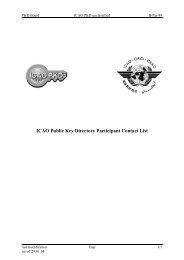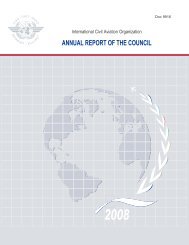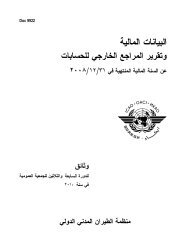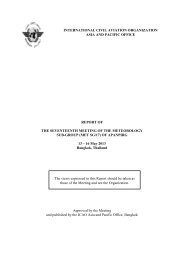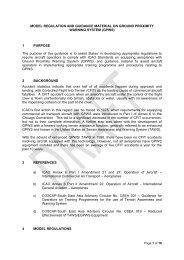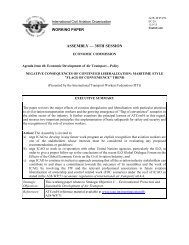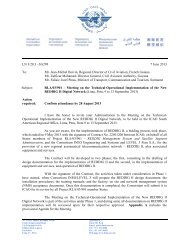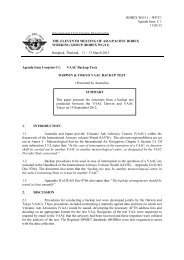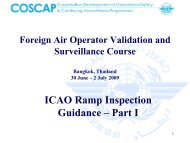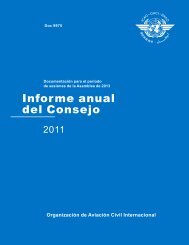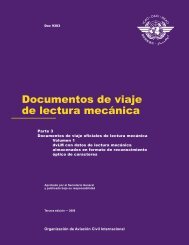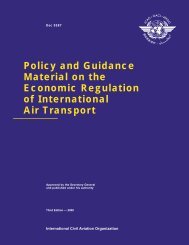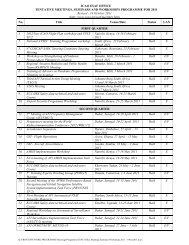afi met bulletins exchange (ambex) handbook - ICAO
afi met bulletins exchange (ambex) handbook - ICAO
afi met bulletins exchange (ambex) handbook - ICAO
You also want an ePaper? Increase the reach of your titles
YUMPU automatically turns print PDFs into web optimized ePapers that Google loves.
AMBEX HANDBOOK 7th Ed. 29/58<br />
11. INTER-REGIONAL OPMET EXCHANGE - IROG FUNCTIONS<br />
11.1 Inter-regional OPMET Gateways (IROGs) are designated in the AFI Region for the the<br />
purpose of exchanging OPMET data between the AFI and the other <strong>ICAO</strong> Regions, as shown in the table<br />
below.<br />
AMBEX IROG For Excchange of OPMET data between Regions<br />
Dakar AFI and EUR; SAM, NAM, CAR; MID, ASIA/PAC as backup to Pretoria<br />
Pretoria AFI and MID; ASIA/PAC, EUR; SAM, NAM, CAR as backup to Dakar<br />
11.2 IROGs and their functions are described at Appendix D. IROGs arrange for relaying all<br />
AMBEX <strong>bulletins</strong> to a corresponding OPMET Gateway in the other <strong>ICAO</strong> regions concerned. In<br />
particular:<br />
• Dakar IROG relays all AFI <strong>bulletins</strong> to ROC Toulouse in the EUR Region, which serves the<br />
EUR, SAM, NAM and CAR Regions, and should receive and store all required OPMET <strong>bulletins</strong><br />
from these Regions;<br />
• Pretoria IROG relays all AFI <strong>bulletins</strong> to ROC Toulouse in the EUR Region and IROG Bangkok<br />
in the the ASI/PAC Regions, and should receive and store all required OPMET <strong>bulletins</strong> from<br />
MID, ASIA/PAC, EUR, SAM Regions;<br />
11.3 The following principles are applied to IROGs:<br />
a) IROGs should have reliable and efficient AFTN connection to the regions, for which they have<br />
<strong>exchange</strong> responsibilities, with adequate capacity to handle the OPMET data flow between the<br />
regions;<br />
b) IROGs should be associated with AFTN relay centres capable of handling efficiently the volume<br />
of traffic anticipated;<br />
c) IROGs should be capable of handling all OPMET data types, as described in para.4.1.1.<br />
11.4 In order to avoid duplication of the OPMET traffic and information, all inter-regional<br />
OPMET <strong>exchange</strong> should be directed through the IROGs. Inter-regional <strong>exchange</strong> via direct AFTN<br />
addressing from the originator or AMBEX centre to recipients in the other <strong>ICAO</strong> Regions should be<br />
avoided, except when bilateral or other agreements require such direct <strong>exchange</strong>s.<br />
12. MANAGEMENT OF OPMET EXCHANGE UNDER THE AMBEX SCHEME<br />
12.1 OPMET Bulletins Update Procedure<br />
12.1.1 Information for changes of AMBEX <strong>bulletins</strong> should be disseminated to all AMBEX<br />
centres and national OPMET centres (NOC) concerned well in advance in order to allow the centres to<br />
introduce the necessary changes to their message handling systems. In this regard, a lead time period of<br />
two months (or two AIRAC cycles) is considered appropriate.<br />
12.1.2 The AMBEX centre planning the change, should send a notification by e-mail or fax to the<br />
<strong>ICAO</strong> Office, Dakar or Nairobi with copy to all AMBEX Focal Points. The notification should include



